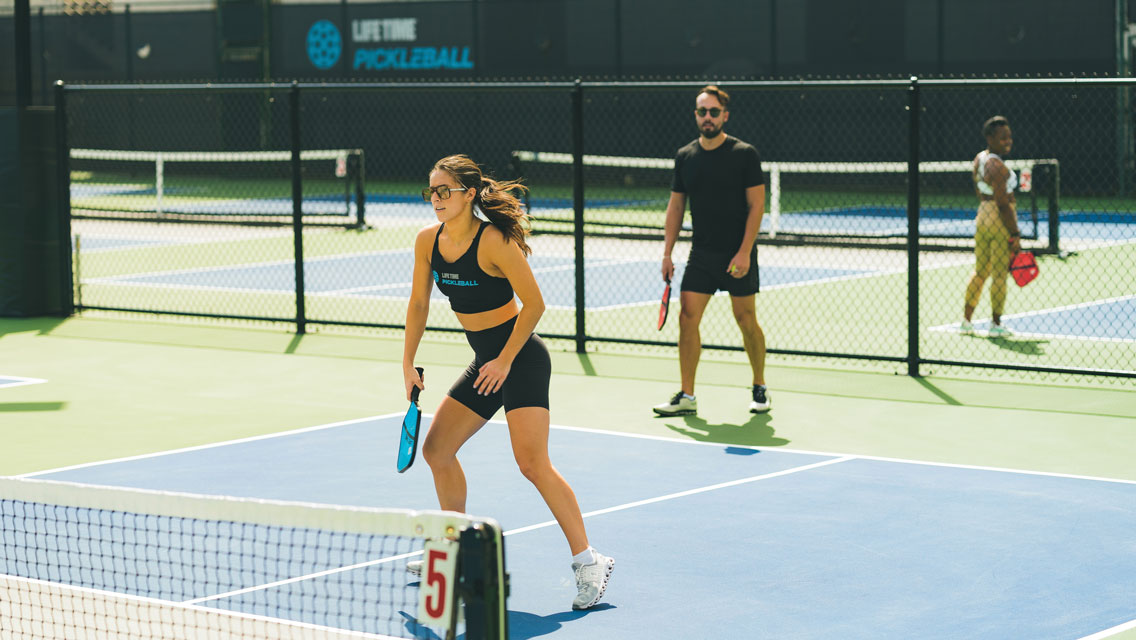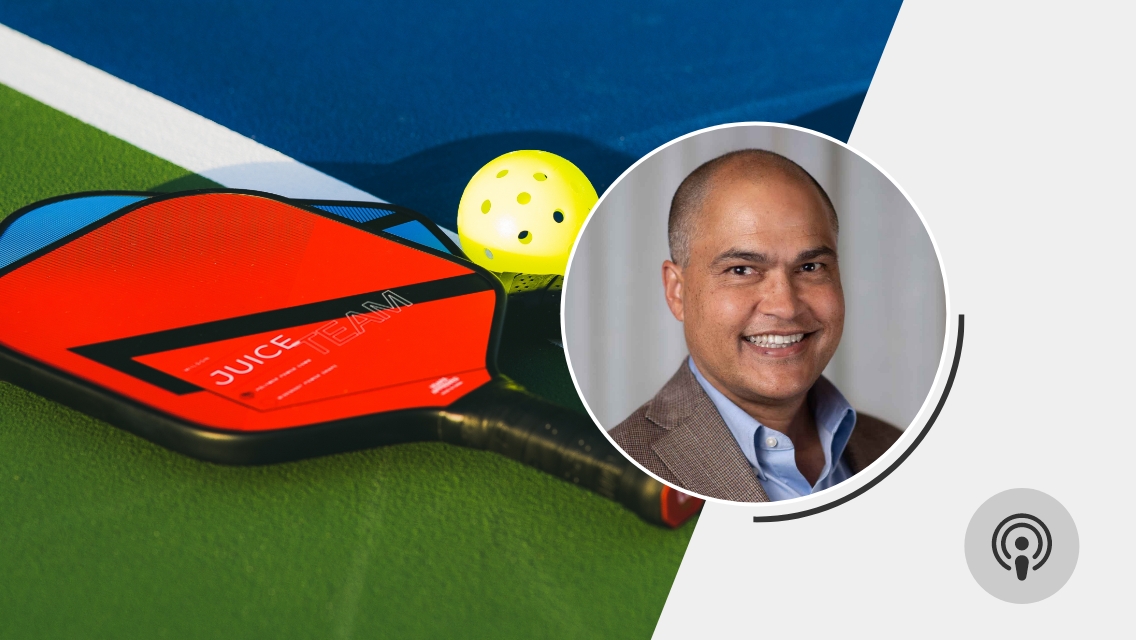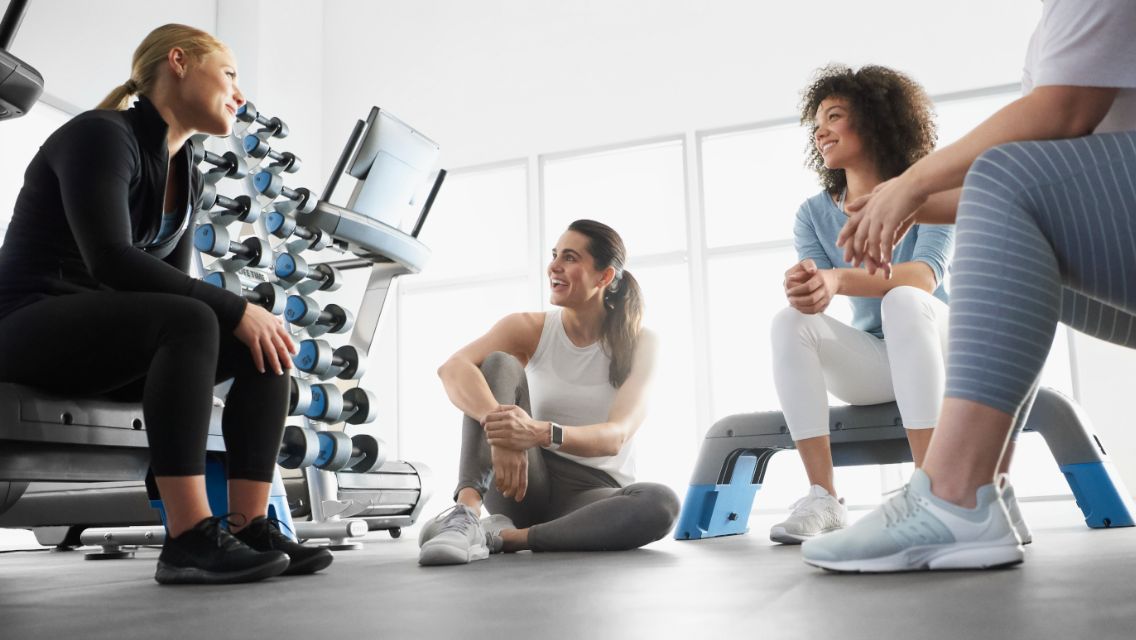ARTICLE SHORTCUTS
It may have a funny name, but pickleball is no joke. In fact, it’s the fastest-growing activity in the country. According to a 2022 report, the Sports and Fitness Industry Association estimates that 4.8 millioån Americans play the sport. That number grew by 39.3 percent during the pandemic, beating out all other U.S. sports.
“The sport of pickleball is derived from tennis, badminton, and Ping-Pong,” explains Katie Easter, pickleball lead for Life Time’s Bloomington North club in Minnesota. “The people are diverse in age, gender, and ethnicity. You can walk onto the pickleball court with any kind of court experience — or none at all — and learn the game pretty easily.”
Ajay Pant, Life Time’s senior director of racquet sports, admits he was “quite skeptical” about the popular sport, but he quickly became a convert. “I played once and got addicted — and this addiction is the norm, not an aberration.”
Pickleball can indeed become a lifestyle, says Laura Gainor of USA Pickleball. “Once you start, you typically quickly become addicted because of its fun and social nature. It has a multigenerational appeal for people of all skill levels to be able to play together, so many families over the past couple of years have used it to stay active and healthy together, either playing in their driveway or on local community courts.”
One family that’s taken it to another level is the duo of Leigh Waters and her daughter, Anna Leigh Waters, who started playing pickleball in 2017 and soon began winning local tournaments in Florida. Anna Leigh went pro at age 12, becoming the youngest professional pickleball player in the world. Now 15, she’s still dominating the circuit.
“What drew us to the sport was the fact that we could play with our family of all ages and abilities. It was something fun that we could all do together,” says Leigh Waters. “The sport is so inclusive and so social. People line up at the parks every morning to play together and have a great time.”
But it’s not only fun, social, and family-friendly. “Pickleball is a full-body cardiovascular workout,” says Pant. “It burns 40 percent more calories than walking — while still being very low-impact on your knees and your lower back.”
To make the most of your time on the court, get ready for a match with a dynamic warm-up. (For a full warm-up, see “The Art of the Warm-Up“.)
And when playing, stay light on your feet. Pro pickleballer Catherine Parenteau recommends doing simple mobility exercises to improve your court coverage.
The Waters family and other expert picklers offer a few insider tips and tricks for enhancing your game — and your enjoyment of the sport.
Pickleball Terms
It’s probably no surprise that a game with a name like “pickleball” comes with some unique vernacular. Here’s a short list of important terminology.
- The Kitchen: Another term for the nonvolley zone, the section of court adjacent to the net
- Volley Llama: An illegal move where a player hits a volley shot in the kitchen
- Pickledome: The court where a tournament’s championship match is played
How to Play
1. Practice Your Dink Shot
A dink shot is a soft return hit on a bounce from the nonvolley zone, intended to arc over the net and land within the opposing nonvolley zone, either straight across or diagonally crosscourt. An effective dink arcs downward as it crosses the net, creating a more difficult shot to return than a power shot.
“Good pickleball is about touch and soft hands while dinking in the kitchen area,” says Pant. “It’s cat and mouse with your opponent. Dinking is a game of attrition. If you can keep the ball low and short enough times, your opponent will probably make a mistake!”
Practice dinking every time you play, he suggests. Simply start out with only dink shots with your partner, and practice all patterns — forehand to forehand, forehand to backhand, backhand to backhand.
2. Arc Your Third Shot Drop
The third shot drop is a drop shot that comes after the serve and return. By arcing the ball and landing it into your opponent’s kitchen, or nonvolley zone, you give your team time to get to the net, which improves your chances of winning the rally.
“When you serve, because of the two-bounce rule, you start at a disadvantage since your opponent can rush the net,” says Pant. (The two-bounce rule requires the receiving team to let the ball bounce once before returning it and requires the serving team to let the ball bounce before hitting the third shot. After the two bounces, the ball can be hit out of the air.) “If you float the third shot, your opponent will punish you with a volley,” he explains.
Practice dinking this third shot with a partner. A dink shot will ensure that the ball stays low, making it harder for your opponent to volley down. A successful dink as your third shot also gives you time to creep up to the kitchen and challenge your opponent.
3. Call the Score
“One of the most difficult things for many people to learn is how to call the score,” says David Huntley, an Atlanta-based professional pickleball coach. Three numbers are called; a typical score may be called 5-6-2. This means the serving team’s score is 5, the returning team’s score is 6, and the third number is always 1 or 2 — based on whether the team’s first or second server is about to serve.
“Another thing about the scoring that can be confusing is that you can only get a point when you are the serving team,” says Huntley. “When you ‘win a point’ while the other team is serving, you do not get a point; you only get the serve back to your team.” (In doubles, you get the serve back only after both opponents have served and faulted.)
4. Calm Your Nerves
“One of the questions we get the most from pickleball players across the board is what to do when you get nervous or start to feel uncomfortable on the court during play,” says Leigh Waters. “Take deep breaths, watch the ball, and keep your feet moving. This will help your body to relax and give your mind something to focus on other than the fact that you’re nervous!”
6 Cone Drills for Agility
Staying light on your feet is essential to playing pickleball. Professional pickleball player Catherine Parenteau offers these six cone-drill exercises to help you cover the court. Repeat each drill for 30 to 45 seconds before moving on to the next. Perform four rounds of the six-drill circuit.
1. Shuffle Runs
Place four cones in an L shape with about eight feet between the cones. Shuffle to the side, run forward, shuffle in the opposite direction, and run forward.
2. Crossover Runs
Place three cones in an L shape, again with eight feet of space between the cones. Cross your outside foot over the inside to initiate the side-shuffle to the first cone, run forward to the second cone, cross the opposite foot to side-shuffle in the opposite direction, and run forward.
3. Diagonal Shuffles
Place four cones in a zigzag shape, with about eight feet between the cones. Shuffle to each cone, touching them each time.
4. Backpedal Runs
Place three cones in an L shape, again with eight feet of space between the cones. Run backward to move across the space, forward to move to the next cone, and repeat.
5. Forehand/Backhand Drills
Place two cones about eight feet apart. Grasping your racquet, run across to one cone, practice your forehand, and run back. Start with your forehand only, then your backhand.
6. Combined Practice Drill
Using three cones this time, run to each side cone practicing both your forehand and your backhand, returning to your center cone as your base each time.
This article originally appeared as “Welcome to the Pickledome” in the October 2022 issue of Experience Life.






This Post Has 2 Comments
Is it possible to show a visual of these six drills or have a video to demonstrate? I see myself tripping all over trying to get those drills right.
Nice info